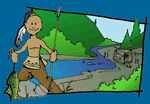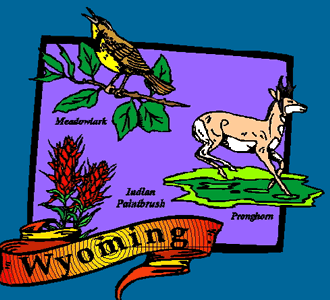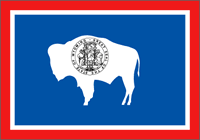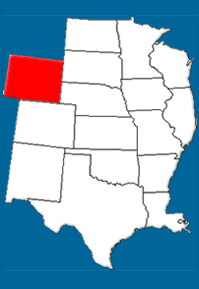


Geography and Landforms:
Wyoming is bordered by Montana on the north and Utah and Colorado on the south. On the east, Wyoming is bordered by South Dakota and Nebraska. On the west, Wyoming is bordered by Idaho and Utah. Wyoming is the second "highest" state in the US, having a mean elevation of 6,700, second only to the state of Colorado.
|
 History:
Since the 16th century, a number of governments have claimed parts of what is now the State of Wyoming. The national flags of France, Great Britain, Mexico, Spain, Texas, and the United States have flown over the Wyoming Territory, as well as the territorial flags of the Dakotas, Idaho, Louisiana, Missouri, Nebraska, Oregon, Utah, and Washington. |
 Economy:
Wyoming's towering mountains and vast plains provide spectacular scenery, grazing lands for sheep and cattle, and rich mineral deposits.
|
 First Inhabitants:
People were living in the area we now call Wyoming more than 12,000 years ago. These people were probably part of the Clovis culture. In the next two to four thousand years, there is evidence of other cultures living and moving through this area including people who hunted big game, including animals that no longer exist, like the wooly mammoth.
|
Books Related To WyomingC is for Cowboy: A Wyoming Alphabet - Eugene Gagliano The Case of the Missing Cutthroats - Jean Craighead George Dinosaur Hunter - Elaine Marie Alphin The Haymeadow - Gary Paulsen My Friend Flicka - Mary O'Hara Paint the Wind - Pam Munoz Ryan Scumble - Ingrid Law Walker's Crossing - Phyllis Reynolds Naylor |
Famous Citizens:
|
| Capital: | Cheyenne |
| Entered Union: | July 10, 1890 |
| Population: | 584,153 |
| Area | 97,814 |
| Bird | Western Meadowlark |
| Flower | Indian Paintbrush |
| Nickname: | Equality State |
| Governor | Matthew Mead |
Places to Visit in Wyoming: (Click the links to learn more.)
|



